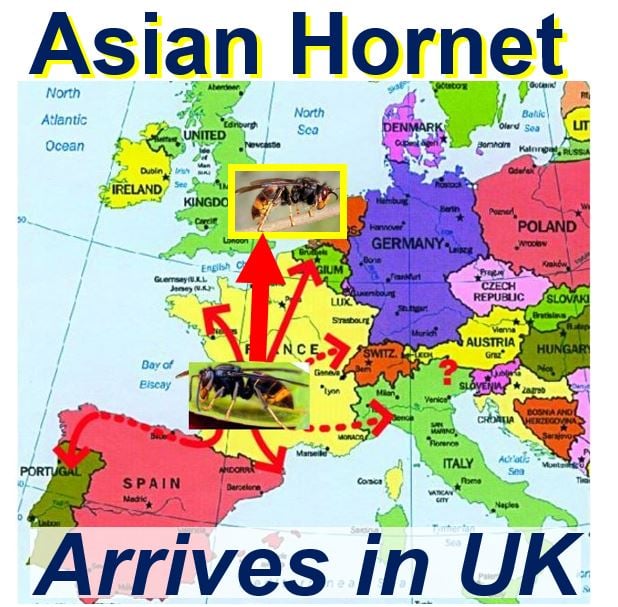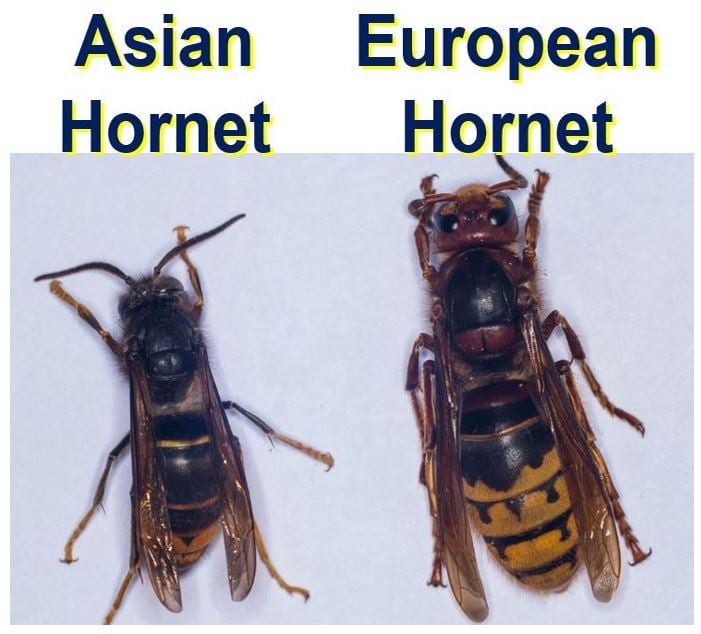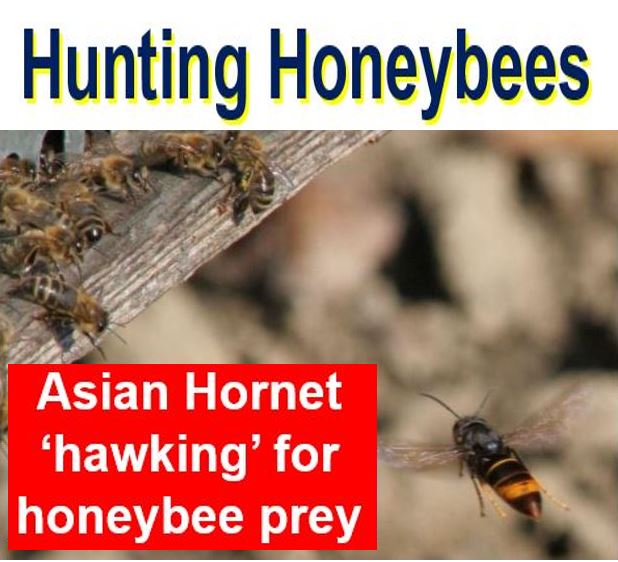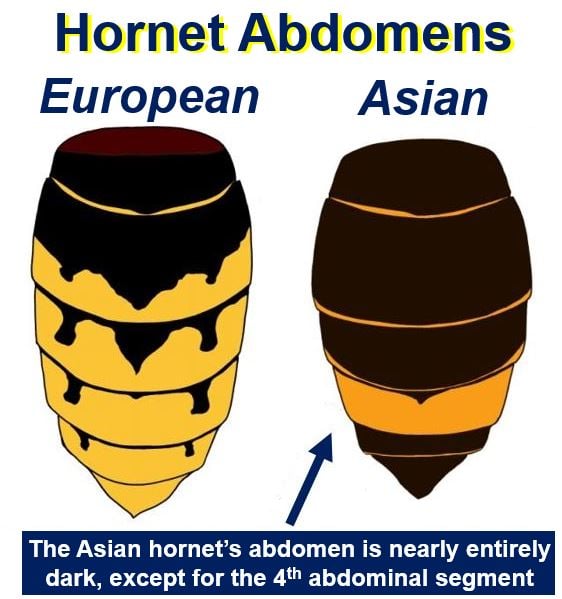The Asian Hornet has been sighted in Gloucestershire, in the Tetbury area, says the National Bee Unit. This is the first sighting of a wild Asian hornet (Vespa velutina) in the United Kingdom. It is smaller than our native hornet and poses no greater risk to human life or health than a bee. However, they can devastate populations of honeybees.
According to DEFRA (Department for Environment, Food & Rural Affairs), work to identify, destroy and eliminate any nests is already underway. Authorities have:
– set up a three-mile surveillance zone around Tetbury,
– opened a local control centre to coordinate responses,
– deployed bee inspectors throughout the area. They will be using infrared cameras and traps to locate Asian hornet nests,
– readied nest disposal experts who will kill the hornets using pesticides and destroy any nests.
 The Asian Hornet, sometimes called the Yellow-Legged Hornet, generally nests high up in trees and man-made structures. Nests have also been seen closer to the ground. It preys on honeybees and other pollinating insects, and also feeds on flowers and fruit. (Image: adapted from nonnativespecies.org. Downloads as a PDF file)
The Asian Hornet, sometimes called the Yellow-Legged Hornet, generally nests high up in trees and man-made structures. Nests have also been seen closer to the ground. It preys on honeybees and other pollinating insects, and also feeds on flowers and fruit. (Image: adapted from nonnativespecies.org. Downloads as a PDF file)
Defra Deputy Director for Plant and Bee Health, Nicola Spence, said regarding the expected arrival of Vespa velutina:
“We have been anticipating the arrival of the Asian hornet for some years and have a well-established protocol in place to eradicate them and control any potential spread.”
“It is important to remember they pose no greater risk to human health than a bee, though we recognise the damage they can cause to honey bee colonies. That’s why we are taking swift and robust action to identify and destroy any nests.”
“We remain vigilant across the country, working closely with the National Bee Unit and their nationwide network of bee inspectors.”
A local control centre has been opened near Tetbury. Bee inspectors from across the country will be closely monitoring a three-mile radius around the area where the initial sighting occurred.
 The Asian Hornet entered Europe in France in 2004, where it reproduced and spread rapidly. Experts have been warning of an imminent UK invasion, with the insect most likely coming into the country hidden in cut flowers, imported fruit, plants, freight containers, garden items (plant pots, furniture, etc.) and untreated timber. (Image: adapted from vita-europe.com)
The Asian Hornet entered Europe in France in 2004, where it reproduced and spread rapidly. Experts have been warning of an imminent UK invasion, with the insect most likely coming into the country hidden in cut flowers, imported fruit, plants, freight containers, garden items (plant pots, furniture, etc.) and untreated timber. (Image: adapted from vita-europe.com)
Ms. Spence added:
“They (bee inspectors) will be supported by nest disposal experts who will use an approved pesticide to destroy any hornets and remove any nests.”
The Asian hornet specimen that was found in Tetbury has been sent to the National Bee Unit in North Yorkshire for DNA testing to help determine how it arrived in Britain.
Vespa velutina arrived in France in 2004 hidden in a shipment of Chinese pottery. It is commonly sighted across huge areas of continental Europe. It was first discovered in Alderney and Jersey in the summer of this year.
According to experts, the species will not be able to survive the cold winters in the northern parts of the UK.
DEFRA asks members of the public to:
– Go to the non-native species website for advice on what to do if they think they have seen an Asian hornet.
– Not to go near a nest if they think they have spotted one. Contact [email protected] immediately.
The cost of eradication on private land will be covered by APHA (Animal & Plant Health Agency).
The onBee Base Guide or the Non-Native Species Identification Guide provide details on the appearance of the Asian hornet.
 The Asian Hornet is considerably smaller than its European cousin. Unlike its European counterpart, it is a day-flying species that ceases activity at dusk. (Image: i.dawn.co)
The Asian Hornet is considerably smaller than its European cousin. Unlike its European counterpart, it is a day-flying species that ceases activity at dusk. (Image: i.dawn.co)
Difference between wasps, hornets and bees
What’s the difference between a hornet, a wasp and a bee?
– Wasps have either very little or no hair at all. They are black and bright yellow, have an aggressive nature, don’t swarm, and will sting readily and repeatedly. They feed on insects, food waste and sugary drinks.
– Hornets have some hair, more than wasps but less fur than bees. They are yellow and chestnut brown, don’t swarm, and only sting when they are provoked. Hornets are able to bite and sting simultaneously. They feed on insects, fruit and flowers.
– Bees are furry insects. Their colours depend on which type – the honey bee, for example, is brown or black intermixed with amber. Bees are gentle by nature and only sting once. After stinging the bee dies. They feed on nectar from flowers.
 Asian Hornets are extremely aggressive insect predators. They pose a significant threat to British honeybees and other insect pollinators. (Image: nonnativespecies.org)
Asian Hornets are extremely aggressive insect predators. They pose a significant threat to British honeybees and other insect pollinators. (Image: nonnativespecies.org)
Stopping invasive species spread in Europe
Tough new European Union (EU) controls, which came into force in January 2016, aim to stop the spread of 37 invasive species. While praising the move, experts say the scale of the problem is huge.
According to the Wildlife and Countryside Link, invasive non-native species (INNS) cost the UK taxpayer more than £1.7 billion each year to control. Out of approximately 2,000 non-native species we know about in the UK today, over 300 are invasive – the number of INNS is growing rapidly each year.
Invasive species and bird extinctions
Since the beginning of the 19th century, INNS have been the main causes of many bird extinctions. Approximately half of all bird extinctions globally have been due to INNS since 1500.
Earlier this year, when experts were warning about the inevitable arrival of the Asian hornet to the UK, Chair of the Wildlife and Countryside Link’s Invasives Group, Camilla Keane, said:
“Like all invasive non-native species, once established the Asian hornet would be incredibly difficult and hugely costly to tackle.”
“While we recognise the UK Government played an important role in developing the EU Invasive Alien Species Regulation as well as the list of 37 species of EU concern, during Invasive Species Week, we are calling on the Government in England to work with devolved administrations to develop a list of invasive alien species of UK-wide concern as set out in the EU IAS Regulation.”
“This would support collaborative working across the EU and help prevent species like the Asian hornet reaching our shores.”
 Apart from being smaller, the Asian hornet has different abdomen colourings. (Image: nonnativespecies.org)
Apart from being smaller, the Asian hornet has different abdomen colourings. (Image: nonnativespecies.org)
Asian hornet preys on honeybees
Over the past twenty years, Europe’s honeybee population has declined alarmingly. British honeybees’ worst nightmare – an invasion of the Asian hornets – appears to have become reality.
The Asian hornet eats honeybees and other pollinating animals in massive quantities. Like all INNS, they cause significant environmental and economic damage.
The Asian hornet spread rapidly from France twelve years ago to Belgium, Italy, Portugal, Spain, some other parts of Europe, and now the UK.
It is smaller than the native European hornet (Vespa crabro). It has an almost entirely dark abdomen and yellow tips to its legs.
Asian hornet not a threat to humans
The Asian hornet should not be confused with the Giant Asian hornet (Vespa mandarinia), an extremely aggressive and dangerous insect that has been known to have a fatal sting.
Asian hornets are no threat to us directly – they cannot kill us or make us ill. However, they can devastate honeybee and other pollinator populations. The UK Biological Records Centre urges members of the public to get in touch if they think they saw one.
Ms. Keane said:
“Sadly many other invasive species already wreak havoc in our countryside, and new invasive non-native species are arriving each year, so the issue is not going away. However, there is a lot people can do to help combat the problem.”
“From not growing particular plants in your garden, composting garden waste wisely, to cleaning down your equipment after fishing or boating. There are a number of small steps like this that can dramatically reduce the spread of INNS.”
Video – Asian Hornets seen in UK for first time
This ITV News video reports on the bee-eating Asian Hornets that have been spotted in the United Kingdom in Tetbury in Gloucestershire.

